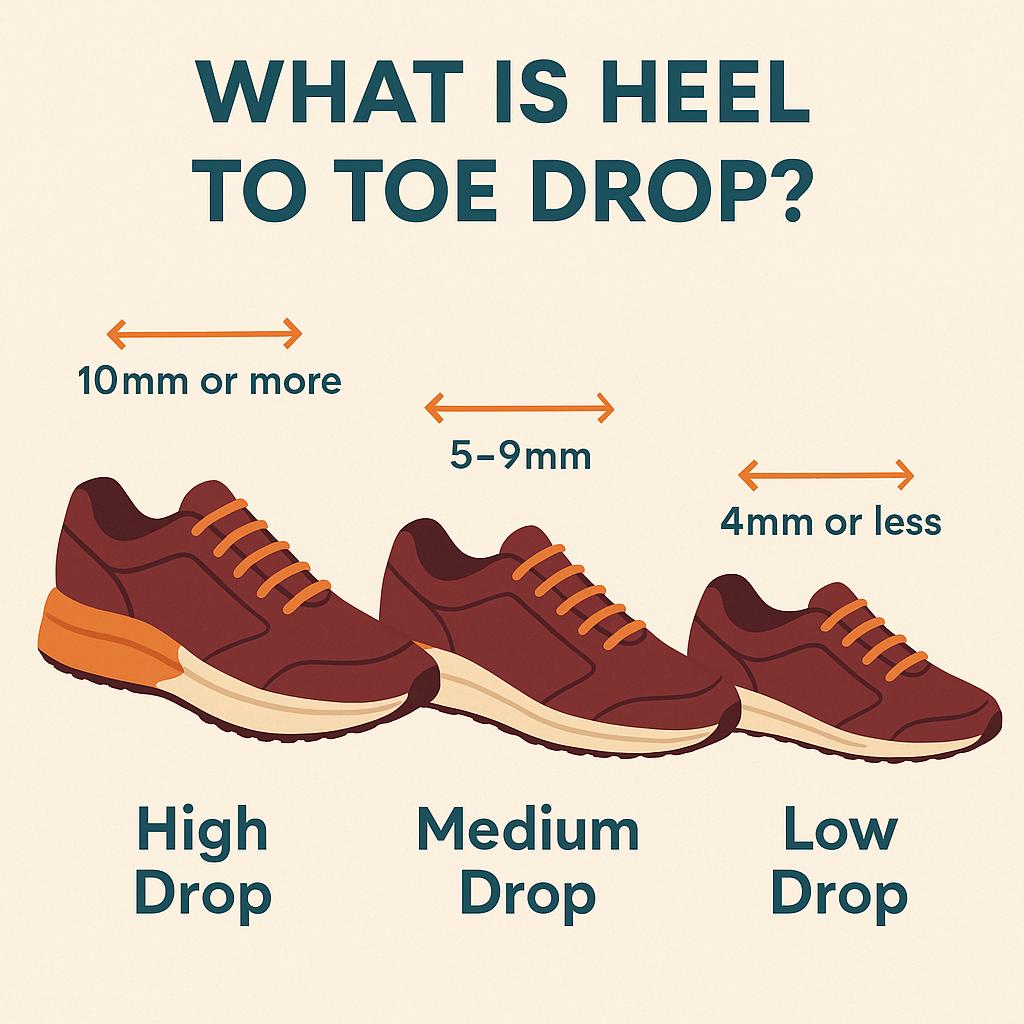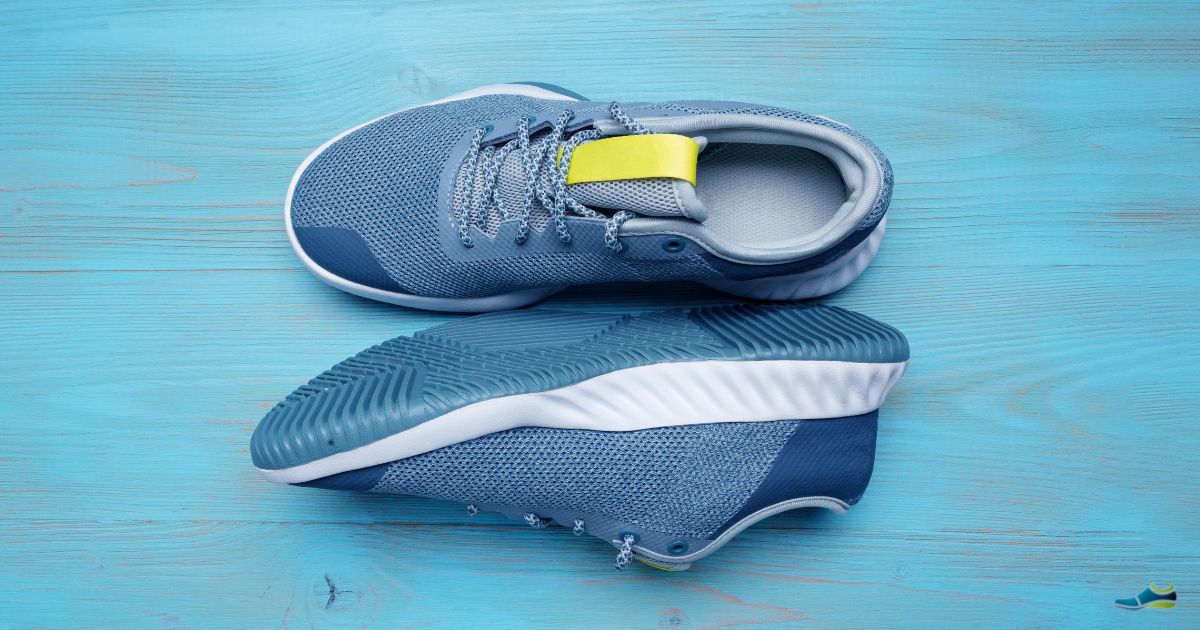When shopping for running or walking shoes, you may have come across the term “heel-to-toe drop.” It’s one of those technical specs that’s often overlooked but can significantly impact your comfort, posture, and even injury risk—especially if you have specific foot health needs or wear wider fitting shoes. In this guide, we’ll explain what heel-to-toe drop means, why it matters, and how to choose the right drop for your feet.
What Does Heel to Toe Drop Mean?
The heel to toe drop—also known simply as “drop”—refers to the difference in height (measured in millimetres) between the heel and the forefoot in a shoe. For example, a shoe with a 10mm drop means the heel is 10mm higher than the forefoot.
The heel to toe drop in shoes affects how your foot strikes the ground and how weight is distributed during movement. It’s particularly relevant for runners but is also important for walkers, people with foot conditions, and anyone wearing orthotics or seeking wider shoes for comfort.
How Heel to Toe Drop Affects Your Gait
Here’s how different drop levels typically affect the way you move:
- High drop (8-12mm): Encourages heel striking. Offers more cushioning at the back, often found in traditional running shoes.
- Medium drop (4-7mm): A more balanced feel. Promotes midfoot striking and is a common choice for general fitness.
- Low drop (0-4mm): Encourages a forefoot or midfoot strike. Mimics barefoot running and strengthens lower leg muscles over time.
Why Drop Matters for Foot Health
While there’s no one-size-fits-all answer, the heel-to-toe drop in shoes you choose can impact your:
- Arch support and comfort: Low drop shoes may place more stress on the arch and Achilles tendon, which can be problematic if you have flat feet or plantar fasciitis.
- Injury prevention: A higher drop reduces tension on the calf and Achilles, but might transfer more impact to the knees.
- Posture and alignment: Drop affects your body’s position. A mismatch can lead to overuse injuries or joint strain over time.
Heel Drop in Wider Fitting Shoes
Wider fitting shoes cater to people with broader feet, bunions, swelling, or foot deformities. But heel drop still matters even if the width fits perfectly. Here’s what to consider:
- Balance and stability: A moderate heel drop (around 6-8mm) often works best for wide shoes, giving good alignment and shock absorption without straining the forefoot.
- Toe splay: Lower drop shoes tend to offer a flatter platform, which enhances toe splay—something especially beneficial in wider fitting footwear.
- Orthotics compatibility: If you use custom insoles or orthotics, pairing them with the right drop ensures optimal function and foot mechanics.
How to Measure Heel-to-Toe Drop
Most shoe brands list the heel to toe drop in their specifications, but if you want to check it manually, here’s a quick method:
- Place the shoe on a flat surface.
- Use a caliper or small ruler to measure the height from the surface to the insole at the heel and forefoot.
- Subtract the forefoot measurement from the heel measurement. That’s your drop in millimetres.
Choosing the Right Drop for Your Needs
When deciding what heel drop is right for you, consider the following factors:
1. Your Activity
- Running: New runners may prefer a higher drop (8-10mm) to cushion heel strikes. Experienced runners or those transitioning to minimalist footwear might opt for 0-4mm.
- Walking: A moderate drop (4-8mm) helps keep posture upright and evenly distributes weight.
- Casual wear: Comfort and stability are key, so a 6-10mm drop often works best for all-day wear.
2. Foot Type and Health
- Flat feet: Choose moderate to high drop (6-10mm) to reduce strain on arches, for detailed information on the best shoes for flat feet follow this link
- High arches: A lower drop may help distribute pressure more evenly.
- Plantar fasciitis or Achilles tendon issues: Higher drops help reduce tension on tendons and soft tissues, however, they should be avoided at the beginning of plantar fasciitis ,for help with pain relief follow here
3. Shoe Fit
When looking at wider fitting shoes, make sure that the drop doesn’t interfere with overall balance. A lower drop with a wide toe box is often preferred by those who value natural movement and ground feel.
Infographic: Understanding Heel-to-Toe Drop

Final Thoughts
If you are still a little unsure about the importance of Heel to toe drop in shoes follow here. It might seem like a minor shoe feature, but it can play a major role in your overall comfort, foot health, and performance. Whether you’re recovering from foot pain, transitioning to wider fitting shoes, or simply want to make smarter footwear choices—knowing your ideal heel drop is a great place to start.
When in doubt, start with a moderate drop and listen to your body. Gradual transitions are key, especially if you’re used to one type of drop and considering a big change.
Frequently Asked Questions
Q: What is considered a high heel-to-toe drop?
A: Anything above 8mm is typically considered a high drop, offering more heel cushioning and encouraging heel-first landing.
Q: Is a zero-drop shoe better?
A: Zero-drop shoes suit people looking for natural movement and strengthening of foot muscles but may not suit those with Achilles or calf issues.
Q: Can heel drop affect knee pain?
A: Yes. A lower drop shifts more impact to your ankles and feet, while a higher drop can shift pressure to your knees. Choosing the right one for your gait is key.
Q: Do all wide-fit shoes have the same drop?
A: No. Heel drop varies across all shoe types, even among wide-fit styles. Always check the specifications.

